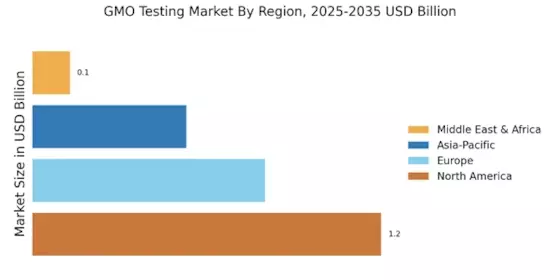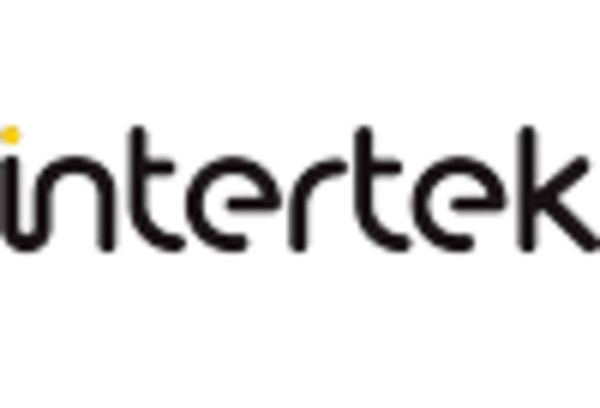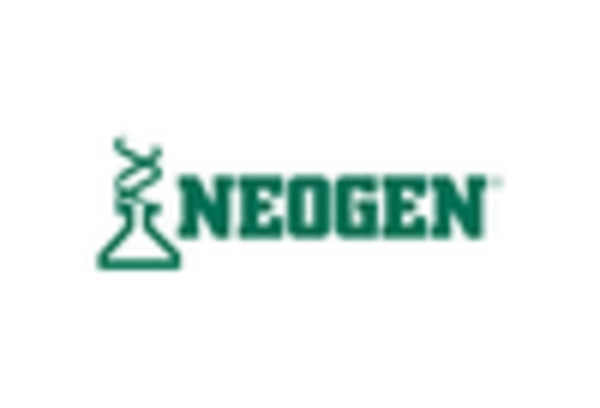Consumer Demand for Transparency
Consumer demand for transparency in food labeling is significantly influencing the GMO Testing Market. As awareness of genetically modified organisms grows, consumers are increasingly seeking information about the products they purchase. This trend has led to a heightened interest in GMO testing, as consumers want assurance that the food they consume is safe and accurately labeled. Market data indicates that a substantial percentage of consumers are willing to pay a premium for non-GMO products, which in turn drives food manufacturers to adopt rigorous testing protocols. The pressure from consumers is prompting companies to invest in testing technologies that can provide clear and reliable information about the presence of GMOs in their products. This shift towards transparency not only enhances consumer confidence but also propels the growth of the GMO Testing Market.
Regulatory Changes and Compliance
Regulatory changes play a pivotal role in shaping the GMO Testing Market. Governments and regulatory bodies are increasingly implementing stringent guidelines regarding the labeling and testing of genetically modified products. For instance, the European Union has established rigorous regulations that require comprehensive testing of GMOs before they can enter the market. This regulatory landscape compels food manufacturers and producers to invest in reliable testing solutions to ensure compliance. As a result, the demand for GMO testing services is expected to rise, as companies seek to avoid penalties and maintain consumer trust. The evolving regulatory environment not only drives the need for testing but also encourages innovation within the GMO Testing Market, as stakeholders strive to develop methods that meet or exceed these regulatory standards.
Research and Development Initiatives
Research and development initiatives are driving innovation within the GMO Testing Market. As scientific understanding of genetic modification advances, there is a growing need for improved testing methods that can keep pace with new developments. Research institutions and private companies are investing in R&D to create more efficient and accurate testing technologies. This focus on innovation is essential for addressing the challenges posed by emerging GMO varieties and ensuring that testing methods remain relevant. Furthermore, collaboration between academia and industry is fostering the development of novel testing solutions that can enhance the capabilities of existing methodologies. The emphasis on R&D not only supports the growth of the GMO Testing Market but also contributes to the overall advancement of food safety and quality assurance.
International Trade and Export Requirements
The dynamics of international trade are significantly impacting the GMO Testing Market. Many countries have established specific testing requirements for GMO products to ensure compliance with import regulations. For instance, nations that import agricultural products often mandate that these goods undergo rigorous GMO testing to prevent the entry of unauthorized genetically modified organisms. This requirement creates a robust demand for testing services, as exporters must ensure their products meet the necessary standards. Additionally, as trade agreements evolve, the need for standardized testing protocols becomes increasingly important. The GMO Testing Market is likely to benefit from this trend, as companies seek to navigate complex international regulations and maintain access to lucrative markets. The interplay between trade and testing requirements underscores the importance of reliable GMO testing in facilitating global commerce.
Technological Advancements in Testing Methods
The GMO Testing Market is experiencing a notable transformation due to rapid technological advancements in testing methodologies. Innovations such as CRISPR and next-generation sequencing are enhancing the accuracy and efficiency of GMO detection. These technologies allow for more precise identification of genetically modified organisms, which is crucial for compliance with stringent regulations. As testing becomes more reliable, the demand for these advanced methods is likely to increase, driving growth in the GMO Testing Market. Furthermore, the integration of automation in testing processes is expected to reduce turnaround times, making it more appealing for laboratories and food manufacturers. This shift towards advanced testing technologies not only improves the quality of results but also supports the industry's efforts to meet consumer expectations for transparency and safety.


















Leave a Comment